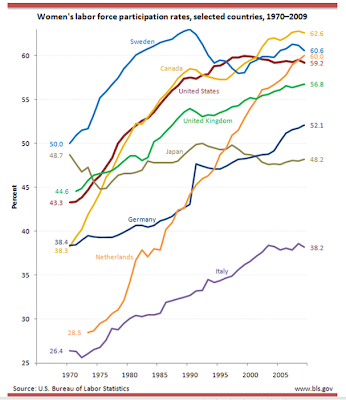
The issue is that many countries want to grow faster. Some structural changes are needed. Many countries are not making the most of what economists have become fond of calling “human capital”. Specifically, increasing the participation of women in the workforce can be potentially a critical development for countries such as Japan and Italy.

This Great Graphic was tweeted by Dan Greenhaus and it draws on data from the US Bureau of Labor Statistics. The data covers the period between 1970 and 2009. It shows Italy as an extreme outlier with women participation a little above 38%. Of course, increased participation does not just happen because the Prime Minister appoints a few women to the cabinet. It requires other societal changes, including arguably better day care for children and elderly. It requires a reorientation of values that de-stigmatizes working wives and mothers.
Still, women participation in the Italian work force has risen over the past three decades and it began at a very low base. Japan, which has the second lowest women participation rate among these selected countries, appears to have gone backwards in the 1990s. Women participation actually slipped from its peak near 50%. The US scores better, but the women participation rate has also slipped in the 1995-2005 period (i.e., before the Great Financial Crisis). Germany and the UK have lower women participation rates that the US, but their improving trend remains intact.
The Dutch trajectory is the most impressive, and it has moved to the upper end of the high income economies. It has surpassed the US. Of the countries shown here, only Canada and Sweden have higher women participation rates.
















